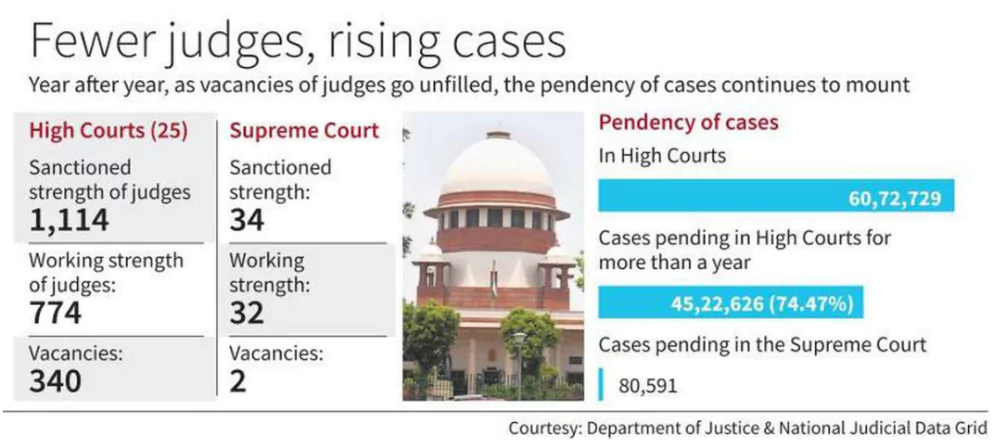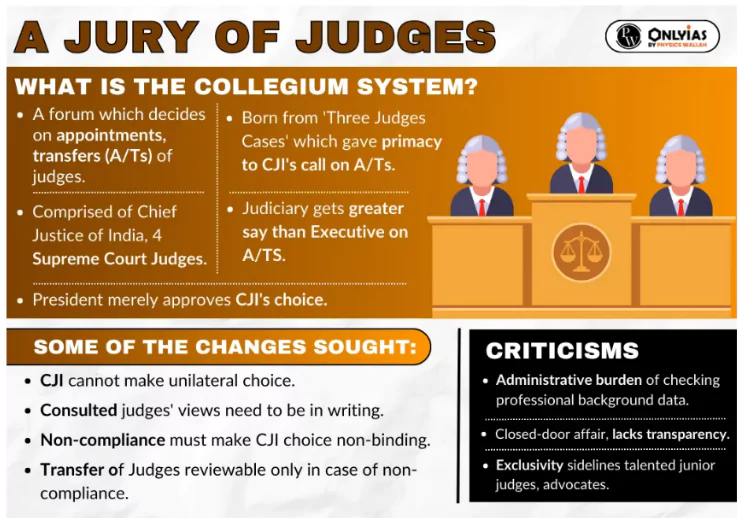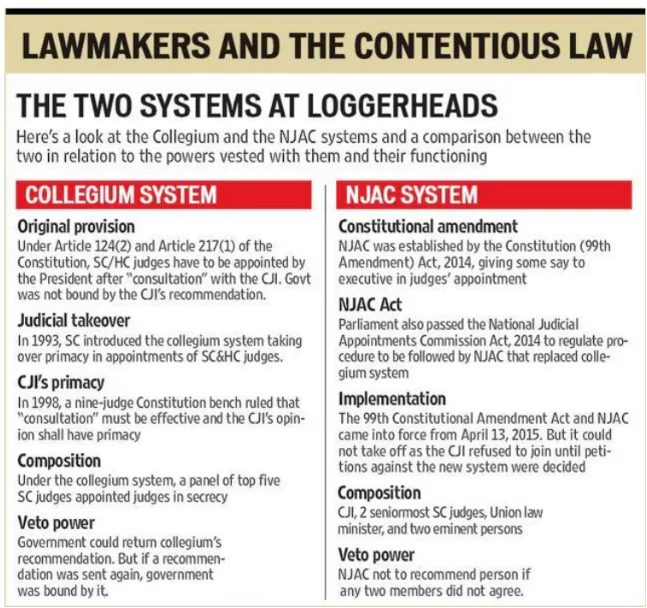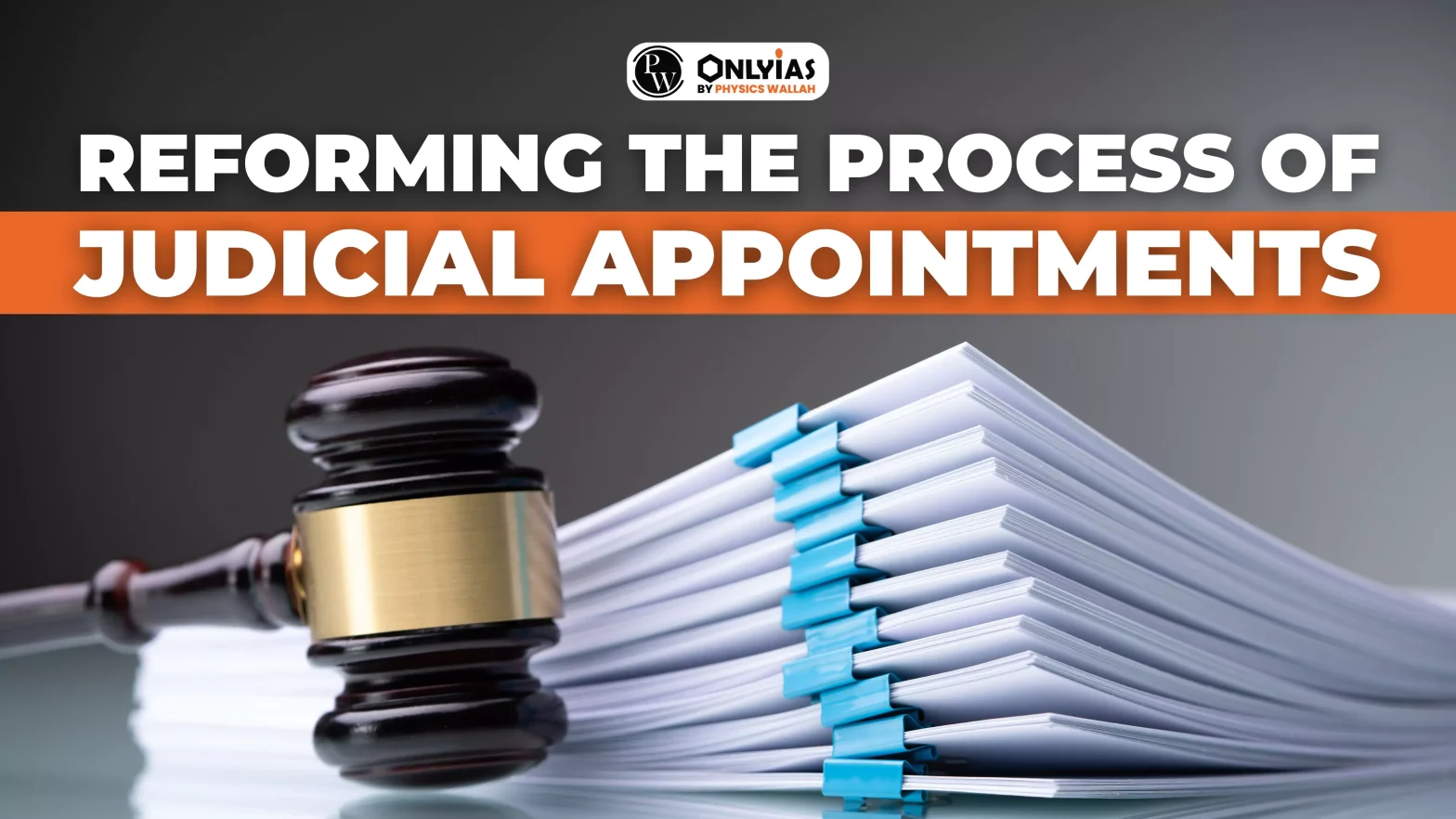The problem of appointment of judges, which is linked to the problem of pendency of cases, has always been a matter of debate in India.
- According to a report published by the Department of Justice, in April, while 60 lakh cases remained pending at various High Courts, 30% of the seats remained vacant.
Status of Judicial Pendency in India
As of June 2024, the status of judicial pendency in India is as follows:

- Supreme Court: The Supreme Court ended 2023 with 80,439 open cases.
- High Courts: 25 high courts have more than 61.7 lakh cases pending.
- District Courts: 4.5 crore out of 5.1 crore cases are pending in district courts, which is more than 87%.
- Other Significant Facts:
- The government is the biggest litigant, with the state sponsoring 50% of pending cases.
- Land and property disputes are the most common type of pending case.
- The pandemic years caused a sharp increase in pendency.
Enroll now for UPSC Online Course
Reasons for High Case Pendency in the Indian Judiciary
Following are the various reasons for high pendency of cases in the Indian Judiciary:
- Delays in Appointments: These are often caused by a standoff between the executive and the judiciary.
- This was exacerbated when the NJAC Act, 2014, and the 99th Constitution Amendment, 2014 was struck down.
- These sought to give politicians and civil society a final say in the appointment of judges to the highest courts.
 Shortage of Judges: The scarcity of judges within the Indian judiciary is a key factor contributing to the backlog.
Shortage of Judges: The scarcity of judges within the Indian judiciary is a key factor contributing to the backlog. -
- As on September 1, 2021, the Supreme Court had one vacancy out of the sanctioned strength of 34 judges.
- In the High Courts, 42% of the total sanctioned posts for judges were vacant (465 out of 1,098).
- As on February 20, 2020, in subordinate courts, 21% posts out of the sanctioned strength of judges were vacant.
- India has about 21 judges for every million people. China, by contrast, has about 159 judges for every million people.
- New Mechanisms and Litigation: Innovative mechanisms like Public Interest Litigation (PIL) have expanded the scope of cases brought before the courts. While PIL is valuable for addressing public issues, it also contributes to the caseload.
- PIL is a legal mechanism that allows individuals or groups to approach the courts in order to address issues that affect the larger public or society’s interests.
- Shifting Role of the Supreme Court: From adjudicating cases of constitutional significance into a regular court of appeals or cases of violation of fundamental rights.
- Others: Court vacations, high government litigations, inadequate infrastructure, procedural delays, etc.
Appointment of Judges in India
Through the collegium system, judges are appointed and transferred in the Supreme Court and high courts across the country.
- Constitutional Provisions:
- Article 124: The appointment of Supreme Court judges should be made by the President after consultation with such judges of the High Courts and the Supreme Court as the President may deem necessary.
- Article 217: The appointment of High Court judges should be made by the President after consultation with the CJI and the Governor of the state.
- Procedure of Appointment:
- Supreme Court Judges:
- Recommendations by Collegium: All appointments must be recommended by the collegium.
- Government Approval: This recommendation is then sent to the Central government via the law minister and then the prime minister before the President’s approval.
- High Court Judges:
- Recommendations of Collegium: High Court collegium must send a recommendation to the Chief Minister (CM) and the governor of the state.
- Recommendations of State Executive: The governor will then send the recommendation to the Union Minister of Law and Justice, who will forward the recommendation to the CJI.
- Government’s Approval: The CJI, after being informed by the two senior-most judges of the SC, should send the recommendation to the Union Minister of Law and Justice.
- He/she then puts the recommendations before the Prime Minister who will advise the President about the appointment.
Check Out UPSC CSE Books From PW Store
About Collegium System
The Supreme Court held that the collegium system protects the independence of the judiciary.

- The Supreme Court Collegium: The collegium system is a forum including the Chief Justice of India and four senior-most judges of the SC, which recommends appointments and transfers of judges.
- High Court Collegium: It includes the Chief Justice of the High Court along with its two senior-most judges
- These appointments include elevation of high court judges to the apex court and direct appointments of senior advocates as apex court judges.
- Judges of the higher judiciary are appointed only through the collegium system, and the government has a role only after names have been decided by the collegium.
- Significance:
 A Structured Method: For the appointment and transfer of judges in higher courts.
A Structured Method: For the appointment and transfer of judges in higher courts. - Preservation of the Independence: Independence of judiciary from the executive branch by endowing judges with substantial influence in the appointment of judges.
- Drawback: The collegium system has frequently been criticised for its lack of accountability and transparency, and the prevalence of nepotism.
- In the collegium system, no one knows what the criteria are to select judges. The system offers room for favouritism, which could prevent competent and deserving judges from being appointed.
- Can the Collegium system be replaced?
- Replacing the Collegium system calls for a Constitutional Amendment Bill.
- It requires a majority of not less than two-thirds of Members of Parliament present and voting in Lok Sabha as well as Rajya Sabha.
- It also needs the ratification of legislatures of not less than one-half of the states.
About National Judicial Appointments Commission (NJAC)
NJAC was introduced by the 99th Constitutional Amendment Act, 2014 to regulate the appointment of judges and empower the commission.
- Feature: The NJAC consisted of the Chief Justice of India (as Chairman), two senior most judges of the Supreme Court, the Law and Justice Minister and two eminent persons.
- Struck Down: The Constitution Bench of the Supreme Court declared NJAC unconstitutional citing that it violates the basic structure of the Constitution of India.
- The Court determined that the NJAC may jeopardise impartiality and objectivity in the appointment process, thus endangering judicial independence.
Need for NJAC over Collegium System
The NJAC was an elegant reform. Various experts, including former judges, have argued that the NJAC is a better system. Also, since the world over, the judiciary is not the sole body which appoints judges.
- Faster Appointment: If appointments of judges have to take place faster, there is a need to bring back the NJAC. It could have resulted in faster nominations of judges because of its democratic structure.
- An Efficient Method: The NJAC could provide a more efficient method of appointing judges, encouraging communication between the arms of the state, and addressing some of the perceived drawbacks of the collegium system.
- Inclusiveness: The NJAC Act, 2014 (99th Constitutional Amendment, 2014) sought to give politicians and civil society a final say in the appointment of judges to the highest courts.
- Independence of the Judiciary: Parliament in its wisdom enacted the NJAC Act and in order to give credence to the NJAC, it was to be headed by the Chief Justice of India, and include the Law Minister, two eminent persons, and two senior judges.
Check Out UPSC NCERT Textbooks From PW Store
Way Forward
Following are the various measures that need to be considered to reduce pendency cases in the judiciary system:
- Reworking of NJAC: The NJAC can be reworked by taking into account the views of the judiciary, the executive, and civil society, and the need to strike a balance between judicial independence and accountability.
Lessons from Other Countries:
- UK: The independent Judicial Appointments Commission (JAC) oversees the process of judges appointments.
- The JAC consists of 15 members; from which 12 members are selected through a process of open competition.
- France: The judges are appointed for three-year terms, which are renewable on the recommendation of the Ministry of Justice.
- South Africa: There is a 23-member Judicial Services Commission (JSC) that advises the President to nominate the judges.
- US: Judges of the Federal Court are appointed by the President with the advice and consent of the Senate.
|
- Establish a Comprehensive Regulatory Framework: It should clearly define the criteria, qualifications, and procedures for judicial appointments.
- It should incorporate provisions for transparency in decision-making, merit-based selection, and performance evaluations including the disclosure of reasons for appointments and transfers.
- Strengthen Public Participation: It can be achieved through public consultations, open hearings, or the establishment of a judicial appointments commission that includes representatives from civil society.
- It will incorporate diverse perspectives and promote a more inclusive judiciary that reflects the aspirations and values of society.
- Adopt Alternate Proposal: The government has suggested a three-step process of appointments based on justice Madan B. Lokur’s ruling by involving:
- appointment by way of applications or nominations
- committee of eminent citizens
- submission of a written file to the executive
Appointments based on Justice Madan B. Lokur’s Ruling:
- Appointment by way of Applications or Nominations: Nominations should be made not just by the collegium, but also other judges of the court, the Prime Minister, President and the Attorney General.
- Committee of Eminent Citizens: A participatory appointment process is needed which must seek inputs from a committee of eminent citizens, which would not be restricted to the legal fraternity.
- Submission of Written file to the Executive: The entire file with all views recorded in writing must be sent to the executive for its views on the antecedents, character, integrity and relevant facets” to determine if the candidate was suitable for the post of a senior judge.
|
Conclusion
Attaining this equilibrium is vital for maintaining the rule of law and public confidence in the judiciary. Prior to any plan being finalised, all relevant parties, including the judiciary, legislature, civil society, and Bar Associations should be consulted.
Enroll now for UPSC Online Classes
![]() 2 Sep 2024
2 Sep 2024


 Shortage of Judges: The scarcity of judges within the Indian judiciary is a key factor contributing to the backlog.
Shortage of Judges: The scarcity of judges within the Indian judiciary is a key factor contributing to the backlog. 
 A Structured Method: For the appointment and transfer of judges in higher courts.
A Structured Method: For the appointment and transfer of judges in higher courts. 